Italian adjectives are explained in this post along with examples of how to use them in sentences and how to make sure they agree with the words they modify.
Adjectives are words that describe a name more fully by adding characteristics. ADJECTIVES are buono (good), cattivo (bad), stupido (stupid), intelligent (smart), giovane (young), and vecchio (old).
A few rules must be followed in order to use adjectives appropriately.
Adjectives must agree in gender (masculine or feminine) and number (singular or plural) with the noun they refer to.
We show you how to change the endings so the adjectives agree in number and gender with the words they modify.
Read the explanation to learn more.
How Regular adjectives work
Masculine adjectives end in -o.
Their plural form end in -i
Let’s take the word ➔ GATTO (masculine singular)
We’re referring to the cat’s colour, such as black ➔ NERO.
As GATTO is a masculine noun, everything must agree in the sentence, including the article and the adjective.
SINGULAR FORM
➔ IL GATTO NERO
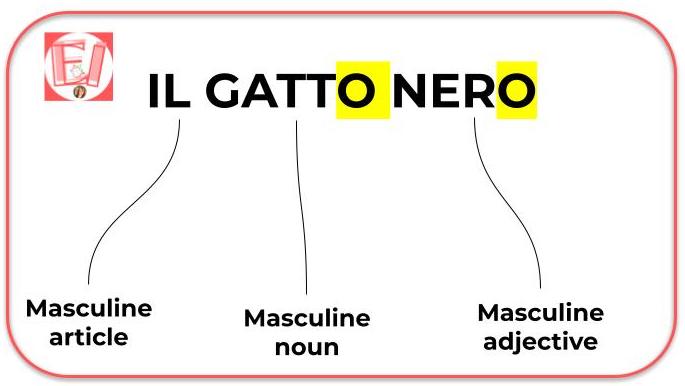
PLURAL FORM
➔ I GATTI NERI
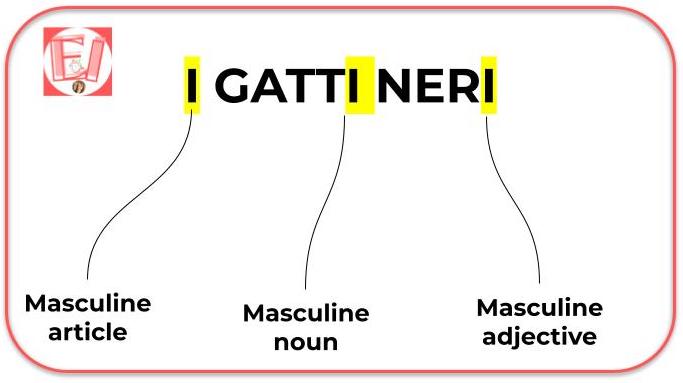
Feminine adjectives end in – a.
Their plural forms end in -e
This time let’s take a female cat with the same colour ➔ GATTA (feminine singular)
As GATTA is a feminine noun, everything must agree in the sentence, including the article and the adjective.
SINGULAR FORM
➔ LA GATTA NERA
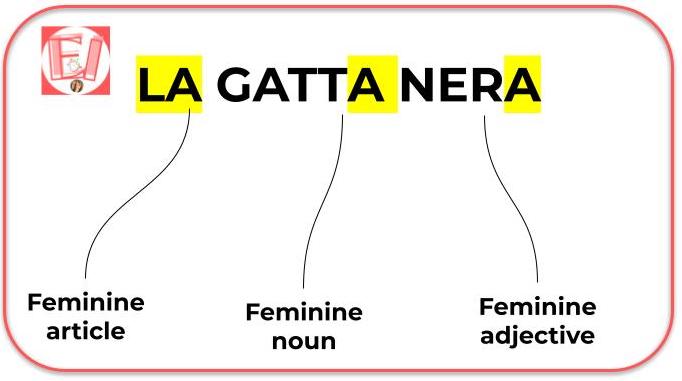
PLURAL FORM
➔ LE GATTE NERE
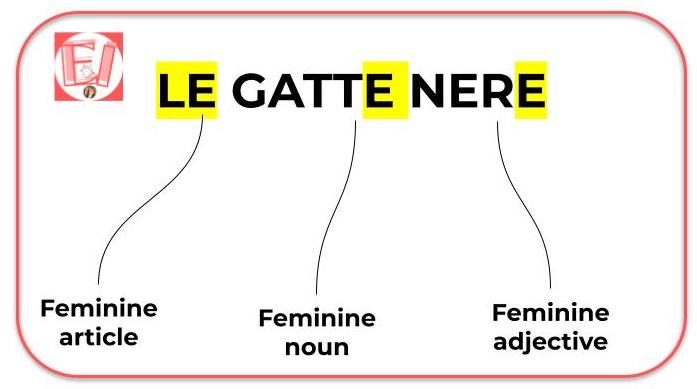
Adjectives ending in -e are both masculine and feminine- Plural forms end in -i
This time let’s take both a female and a male cat ➔ Gatta/Gatto. This time the cat is happy ➔ FELICE
Most adjectives ending in -e have one form used for both the masculine and feminine singular.
Adjectives ending in -e in the singular form, change to -i in the plural forms of the masculine and the feminine.
SINGULAR FORM
➔ LA GATTA FELICE
➔ IL GATTO FELICE
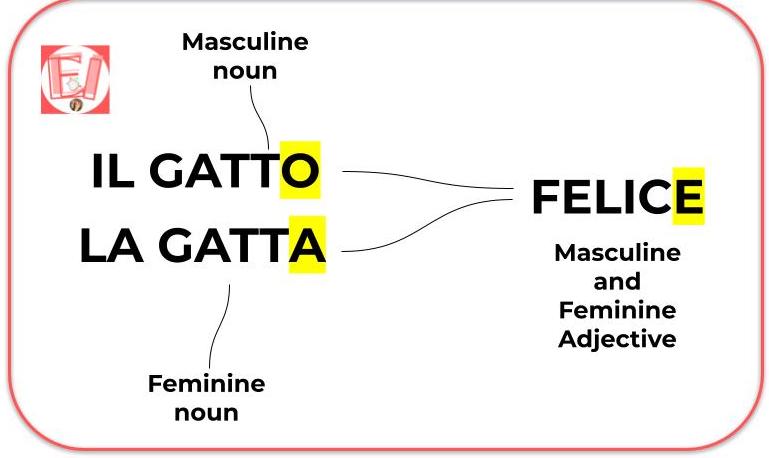
SINGULAR FORM
➔ LE GATTE FELICI
➔ I GATTI FELICI
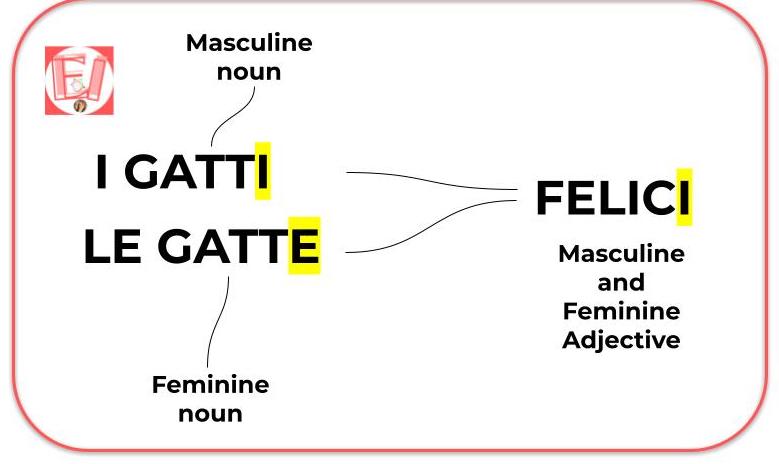
There are, however, some adjectives (like blu, rosa, viola, etc.) that do not change and have the same form for masculine, feminine, singular and plural:
- il vestito rosa ➔ i vestiti rosa
- la giacca rosa ➔ le giacche rosa
- il cappotto blu ➔ i cappotti blu
- la maglia blu ➔ le maglie blu
Italian descriptive adjectives are usually placed after the noun they modify, with which they agree in gender and number.
Learn more about the order in which adjectives appear in a sentence.
Adjectives used to indicate one’s nationality
Italiano, francese, tedesco, giapponese, americano, etc. indicate one’s nationality.
- Adjectives of nationality work similarly: the ones ending in -o are masculine and form their plural in – i.
- Adjectives of nationality ending in -a are feminine and their plural form ends in
- Adjectives of nationality ending in -e are both masculine and feminine. Plural forms end in -i.

Mario è italiano
Italiano is a masculine adjective

Carla è italiana
Italiana is a feminine adjective

Madeleine è inglese
Peter è inglese
Inglese is an adjective
→ masculine
→ feminine
Let’s see other examples of adjectives of nationality
-O
Marocchino
Arabo
Russo
Indiano
Svizzero
-A
Americana
Italiana
Filippina
Greca
Messicana
-E
Tailandese
Svedese
Danese
Norvegese
Francese
The table below shows several frequent Italian adjectives as well as the different adjective endings:
Masculine singular | Feminine singular | Masculine plural | Feminine plural |
|---|---|---|---|
| allegro | allegra | allegri | allegre |
| alto | alta | alti | alte |
| bello | bella | belli | belle |
| buono | buona | buoni | buone |
| difficile | difficile | difficili | difficili |
| felice | felice | felici | felici |
| giovane | giovane | giovani | giovani |
| grande | grande | grandi | grandi |
| intelligente | intelligente | intelligenti | intelligenti |
| nuovo | nuova | nuovi | nuove |
| ordinato | ordinata | ordinati | ordinate |
| magro | magra | magri | magre |
| onesto | onesta | onesti | oneste |
| pigro | pigra | pigri | pigre |
| responsible | responsible | responsibli | responsibli |
| sensibile | sensibile | sensibili | sensibili |
| serio | seria | serio | serie |
| stesso | stessa | stessi | stesse |
| vero | vera | veri | vere |
To practice using Italian adjectives, try creating simple sentences and writing them down, or practice speaking with native speakers and paying attention to how they use adjectives in conversation.
Here are some ways to practice Italian adjectives:
- Use vocabulary lists: Make a list of Italian nouns and adjectives and practice matching them, making sure the adjective agrees in gender and number with the noun.
- Describe objects and people: Pick an object or a person and try to describe them using Italian adjectives, paying attention to the agreement in gender and number.
- Read Italian books and articles: Read Italian books, news articles, and other materials to see how adjectives are used in written Italian.
- Write short sentences: Write short sentences in Italian that include adjectives and practice using the correct form of the adjective based on the noun it modifies.
- Take online quizzes and exercises on our website.
By using these methods, you can practice and improve your Italian adjective skills consistently and effectively.
There are also some irregular adjective forms in Italian, such as “bello” (beautiful), which is masculine singular and feminine singular and plural.
To ensure that you use the correct form of the adjective, you need to study the forms of each adjective and memorize them. Find this topic in our future posts.
What’s next?
You might want to keep learning Italian online with these free resources:










Izzy
TOO HARD 😫😫😫